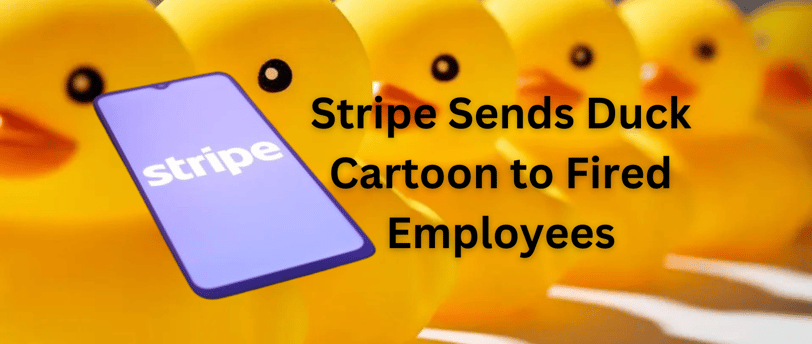Stripe's Quirky Farewell: The Duck Cartoon for Departed Employees
Stripe’s recent mistake of sending a cartoon duck to employees who were laid off has sparked controversy, raising questions about the company’s leadership and communication practices. The image, which was mistakenly attached to termination emails, added confusion and disappointment to an already difficult situation for the 300 affected workers. While the company quickly apologized for the error, the incident highlights the need for more sensitivity in how layoffs are handled, particularly in the tech industry. In contrast to Stripe’s more thoughtful communication during a previous round of layoffs, this mistake undermines the empathy expected from a company of its size and reputation. The incident risks damaging Stripe’s internal culture and public image, especially as more companies are scrutinized for how they treat employees during tough times. Ultimately, the company will need to show through actions, not just words, that it values its employees and is committed to improving its leadership approach.
USA


Stripe Sends Duck Cartoon to Fired Employees
In a highly publicized incident, Stripe, the San Francisco-based fintech giant, sent a cartoon image of a yellow duckling to employees who had just been laid off. The email, which accompanied termination notices, mistakenly included the cartoon, labeled “US-Non-California Duck,” sparking confusion and backlash among the 300 affected workers. The incident occurred as part of a broader restructuring effort by the company, which is known for its rapid growth and massive valuation of $65 billion. While Stripe quickly acknowledged the error, offering an apology to those impacted, the incident has raised important questions about corporate communication, leadership empathy, and the growing challenges faced by laid-off employees in the tech industry.
The Incident and Company Response
According to reports, Rob McIntosh, Stripe’s Chief People Officer, sent an email to those affected, apologizing for the mistake and the confusion it caused. In his message, McIntosh assured the employees that the correct notifications had since been sent. The layoffs primarily affected roles in product, operations, and engineering, with some employees also receiving incorrect termination dates in their email communications. While the cartoon itself may have been an accidental inclusion, it was a blunder that complicated what was already a difficult situation for those impacted.
Stripe’s response, though prompt, underscores the challenges companies face in managing sensitive communications. McIntosh’s apology was well-meaning, but the damage was already done. The image of a cartoon duck accompanying the news of a layoff, no matter how innocent the intent, adds an unnecessary layer of discomfort to an already emotional event.
Why This Matters
Sending a cartoon to laid-off employees is problematic for several reasons. First and foremost, layoffs are a deeply personal and often traumatic experience. Losing one’s job, especially in an uncertain economic climate, can lead to feelings of anxiety, fear, and confusion. For Stripe to accompany that news with a seemingly flippant image feels dismissive of those emotions. Even though the inclusion of the duck image was reportedly an error, it highlights a lack of sensitivity toward the emotional weight of the situation.
Contrast this with Stripe's approach in 2022, when the company had to lay off 14% of its workforce. In that instance, co-founders Patrick and John Collison issued a heartfelt apology, acknowledging their responsibility for the decision. The memo was praised for its transparency and empathy, providing details on severance packages and emphasizing the company's appreciation for the contributions of departing employees. It set a standard for leadership communication that is human-centered and respectful, acknowledging the difficulty of the situation while also offering practical support.
The 2023 incident with the duck cartoon feels like a step back from the approach Stripe took just a few years ago. It underscores the importance of maintaining consistency in leadership communication, especially when navigating sensitive matters like layoffs. Leadership is not just about making the tough calls—it’s also about showing compassion and care, both in the decisions made and the way those decisions are communicated.
The Broader Implications
1. Corporate Culture and Trust
Corporate culture is built on trust, respect, and mutual understanding between leadership and employees. When that culture is disrupted—whether by poor decision-making or a simple mistake—it can have lasting repercussions. The duck cartoon may seem like a minor incident, but it has the potential to erode employee trust in leadership, particularly among those who felt disrespected or dismissed. Even if the gesture was unintentional, it sends the message that the company may not fully grasp the emotional toll layoffs can have on its workforce.
For Stripe, a company known for its innovative technology and strong financial performance, this misstep is especially jarring. Employees may begin to question whether the company truly values them as individuals or if they are just another line item in the balance sheet. Trust, once broken, is difficult to rebuild, and Stripe will need to demonstrate through action that this was an isolated incident and not reflective of its broader corporate values.
2. Leadership Accountability and Communication
Effective leadership requires accountability and the ability to communicate difficult decisions in a clear, respectful manner. The situation with the duck cartoon also underscores the need for leadership to be thoughtful about how information is conveyed. The leaders of a company set the tone for its culture, and in times of crisis, like layoffs, the way leadership communicates can either strengthen or weaken employee morale.
In contrast to the impersonal nature of the duck cartoon, Stripe’s 2022 communication regarding layoffs was more in line with what many consider best practices. By taking ownership of the decision, providing clear details on severance, and expressing genuine regret, the company’s leadership was able to show that they cared about the well-being of their employees—even when tough choices had to be made.
Leaders are expected to manage not just operations but also emotions, especially when employees are affected. A company like Stripe, which has built its brand around cutting-edge technology, should also aim to incorporate emotional intelligence into its leadership practices. The duck incident suggests a lapse in this area, which could lead to questions about how leadership views its responsibility toward its people.
3. Impacts on Brand Reputation and Public Perception
The way Stripe has handled this incident could also have wider repercussions for its brand. As a company valued at $65 billion, Stripe’s reputation is critical—not just among employees but also among investors, customers, and the public at large. Tech companies, in particular, are under increasing scrutiny when it comes to how they treat their employees, especially in the aftermath of layoffs.
While the apology from Stripe’s Chief People Officer may have been sufficient for internal purposes, the incident has already made waves in the media. Negative press surrounding a company’s treatment of employees can tarnish its image, especially in an era where consumers and investors alike are paying more attention to a company’s values and how it operates behind the scenes. For potential employees, a company’s culture and how it treats its people can be just as important as the salary and benefits it offers. Stripe, like other tech companies, will need to work hard to ensure this mistake doesn’t become emblematic of a broader pattern of neglect or indifference.
4. The Evolving Nature of Layoffs in the Tech Industry
Finally, this incident raises broader questions about how layoffs are handled across the tech industry. While layoffs are never easy, the increasing frequency of job cuts in Silicon Valley and other tech hubs has highlighted the need for companies to handle these decisions with even more care and consideration. Companies like Stripe are often viewed as leaders in the industry, so the way they manage layoffs sets a precedent for others to follow.
With the rise of remote work and the pressures of a fluctuating economy, tech companies must recognize that layoffs aren’t just a numbers game. These decisions have real-world impacts on employees’ lives, and as such, they require a level of sensitivity and thoughtfulness that goes beyond corporate efficiency. It’s not enough to simply apologize after a mistake; companies need to proactively address the emotional and financial needs of those impacted by layoffs.
Conclusion
Stripe’s decision to send a cartoon duck to laid-off employees, while seemingly harmless, highlights an important lesson about the importance of leadership empathy, communication, and responsibility. While the blunder may have been accidental, it points to a broader issue: companies must be more mindful of how they handle sensitive matters, especially when it comes to layoffs. Leadership is about more than making tough decisions—it’s also about how those decisions are communicated and how employees are treated throughout the process.
For Stripe, this incident provides an opportunity to re-evaluate its approach to layoffs and employee communication. While the company has already apologized, it must take concrete steps to restore trust and demonstrate its commitment to treating all employees with respect and dignity. In a world where corporate responsibility is increasingly scrutinized, how a company handles layoffs can speak volumes about its values—and in Stripe’s case, the duck cartoon may just be a reminder of how easily a well-intentioned company can lose sight of that.
